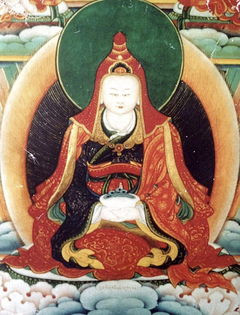Practice of Guru Dewa Chenpo
༄༅། །གུ་རུ་བདེ་བ་ཆེན་པོའི་སྒྲུབ་ཐབས་ཤོག་གཅིག་མ་བཞུགས་སོ། །
The Single-Page Practice of the Guru of Great Bliss
revealed by Chokgyur Dechen Lingpa
རང་རིག་བདེ་བ་ཆེན་པོར་ཕྱག་འཚལ་ལོ༔
rangrig dewa chenpor chaktsal lo
Homage to self-recognizing great bliss!
རང་ཉིད་དབང་ཆེན་ཡབ་ཡུམ་བསྒོམ་པ་ཡི༔
rangnyi wangchen yabyum gompa yi
I visualize myself as the Mighty One1 with consort.
ཐུགས་ཀར་ཙིཏྟ་གྱེན་ལ་བསྟན་པ་ནི༔
tukkar tsitta gyen la tenpa ni
At my heart center, an eight-petalled lotus, slightly open,
པདྨ་འདབ་བརྒྱད་ཅུང་ཟད་ཁ་བྱེའི་ནང་༔
pema dab gyé chungzé kha jé nang
Holds its form like an upward-pointing heart.
ཀུན་རྫོབ་བྱང་སེམས་ངོ་བོ་ཟླ་བའི་སྟེང་༔
kündzob changsem ngowo dawé teng
Within the lotus, on a moon disc symbolizing relative bodhicitta,
རང་རིག་བདེ་བ་ཆེན་པོ་དཀར་གསལ་མདངས༔
rangrig dewa chenpo karsal dang
Rests the Guru of Great Bliss, self-recognizing awareness.
གཞོན་ཚུལ་སྐུ་ཤ་རྒྱས་ཤིང་ལྷུན་ཆགས་པ༔
zhön tsul ku sha gyé shing lhün chakpa
Radiant with a youthful, robust, and impressive presence,
གསང་གོས་ཕོད་ཀ་ཆོས་གོས་དམར་པོ་དང་༔
sang gö pöka chögö marpo dang
Adorned in the secret gown, a wide-sleeved robe, a red Dharma robe,
བེར་ཕྱམ་པཎ་ཞྭ་དམར་པོ་ལྷུབ་པར་གསོལ༔
ber cham pen zhamar po lhubpar sol
A flowing cloak, and a red paṇḍita hat,
བདེ་བའི་སྐྱིལ་ཀྲུང་ཕྱག་གཉིས་མཉམ་བཞག་སྟེང་༔
dewé kyiltrung chak nyi nyamzhak teng
He sits in blissful, cross-legged posture. His two hands, held in equipoise,
བདེ་སྐྱོང་སྣོད་དུ་བྂ་ཡིག་དཀར་དམར་མདངས༔
dekyong nö du bam yikkar mar dang
Support a bliss-sustaining skull cup. Within the cup rests the luminous syllable bam, white with red hue.
དེ་ལས་བདུད་རྩིའི་རྒྱུན་བབས་སྣོད་ནང་ཁེངས༔
dé lé dütsi gyün bab nö nang kheng
Nectar oozes from the syllable,
དེ་ཡང་ཁ་ལུད་ཙིཏྟའི་ནང་གང་བསམ༔
deyang kha lü tsitté nang gang gyur
Filling the skull-cup and causing it to overflow and saturate my heart.
བདེ་བ་ཆེན་པོའི་ངང་དུ་བལྟས་པ་ལ༔
While gazing into great bliss, recite:
ༀ་གུ་རུ་མཧཱ་སུ་ཁ་སིདྡྷི་ཧཱུྂ༔
om guru maha sukha siddhi hung
oṃ guru-mahā-sukha siddhi hūṃ
ཐུན་མཚམས་རྣམས་སུ་གདུང་དབྱངས་འདི་ལྟར་བྱ༔
At the end of the session, chant this yearning song of devotion:
བདག་གི་བླ་མ་གུ་རུ་རིན་པོ་ཆེ༔
dak gi lama guru rinpoche
O Guru Rinpoche, my teacher!
ད་ལྟ་པདྨ་འོད་ཀྱི་ཞིང་ན་བཞུགས༔
danta pema ö kyi zhing na zhuk
While you now reside in the Lotus Light pure land,
བོད་འབངས་སེམས་ཅན་སྡུག་བསྔལ་གྱིས་གདུང་བས༔
bö bang semchen dukngal gyi dungwé
We, the people and beings of Tibet, are wracked with suffering—
ཁྱེད་ཀྱི་ཐུགས་རྗེས་ཉི་མས་བཏང་སྙོམས་སམ༔
khyé kyi tukjé nyimé tangnyom sam
Is your compassion as indifferent as the sun?
རེ་ལྟོས་སྐྱོ་བས་སྙིང་ནས་ཁྱོད་དྲན་ནས༔
ré tö kyowé nying né khyö dren né
As we think of you with profound sadness and hope,
གུས་པས་རྩེ་གཅིག་གསོལ་འདེབས་མི་གསན་ཅིང་༔
güpé tsechik soldeb mi sen ching
If you do not listen to our prayers of wholehearted devotion,
དད་ལྡན་བདག་སོགས་སེམས་ཅན་མི་འདྲེན་ན༔
deden dak sok semchen mi dren na
If you fail to guide faithful beings, like us—
ཡེ་སངས་རྒྱས་པའི་དགོས་པ་ཅི་ཞིག་མཆིས༔
yé sangyé pé göpa chizhik chi
What is the use of being primordially awakened?
བདག་ཅག་ལུས་ནས་གདུང་བའི་མཆི་མ་འཁྲུགས༔
dakchak lü né dungwé chima truk
Our bodies tremble as we weep in distress;
ངག་ནི་གསོལ་འདེབས་འོ་འདོད་ལྷང་ལྷང་འབོད༔
ngak ni soldeb o dö lhang lhang bö
Our voices rise in prayer, calling out with piercing cry;
ཡིད་ནི་རྩེ་གཅིག་ཁྱོད་ཀྱི་རྣམ་ཐར་དྲན༔
yi ni tsechik khyö kyi namtar dren
Our minds recall your liberating life-story one-pointedly.
རྫུ་འཕྲུལ་གློག་བཞིན་གུ་རུ་གནས་འདིར་བྱོན༔
dzutrul lok zhin guru né dir jön
Like a miracle, quick as lightning, Guru, come to this place!
བདེ་གཤེགས་དཀོན་མཆོག་རྩ་བ་རྣམ་གསུམ་གྱིས༔
deshek könchok tsawa nam sum gyi
Encircling you like billowing rainclouds
འཁོར་ཚོགས་ཆར་སྤྲིན་གཏིབས་པ་ལྟར་བཅས་པའི༔
khor tsok chartrin tibpa tar chepé
Are the awakened Three Jewels and Three Roots.
ཕ་ཡིས་ཐུགས་རྗེས་གཟིགས་ཤིག་པདྨ་འབྱུང་༔
pa yi tukjé zik shik pema jung
Our father, Padmasambhava, look upon us with compassion!
བུ་ལ་བྱིན་གྱིས་རློབས་ཤིག་དངོས་གྲུབ་སྩོལ༔
bu la jingyi lob shik ngödrub tsol
Bestow blessings and siddhis on us, your children!
ཞེས་པས་ང་ཉིད་དངོས་སུ་སྐད་ཅིག་འོངས༔
དེར་ཚོགས་རྣམས་ལ་བྱིན་རླབས་ངེས་པར་ཞུགས༔
རྟགས་ནི་སྣ་རེ་མེད་རེ་ན་ར་ཀན༔
Whenever this is uttered, I myself will arrive instantly
And actually bless all those present,
And I vow that a sign of this will appear to each and every one of you.
འདི་ཡི་སྐུ་རྟེན་བདེ་བ་ཆེན་པོ་དང་༔
བདག་གི་སྙིང་ཁྲག་གདམས་པ་འདི་ཉིད་ནི༔
མ་འོངས་ལྷ་སྲས་ཡབ་ཡུམ་གཉིས་ཀྱིས་རྙེད༔
དེ་དུས་འདི་ཡི་བདག་པོ་ས་བཅུའི་མགོན༔
ཐང་གི་ལྷ་དང་ནམ་མཁའི་མཚོ་ཡོད་པར༔
ང་ཡི་སྤྲུལ་པ་ས་མནྟ་བྷ་དྲ༔
ཤིང་སྟག་ལོ་པ་འགྲོ་བའི་མགོན་པོ་འབྱུང་༔
གནས་ལྔར་ཕྱག་མཚན་ལྔ་དང་མཁུར་ཚོས་ལ༔
པདྨའི་རི་མོ་དཔྲལ་བར་དགའ་འཁྱིལ་ཅན༔
ལྟེ་བར་སྨེ་བ་དམར་ནག་སྟག་ཤམ་ཅན༔
དེ་ལ་སྐུ་རྟེན་གསུང་གསང་འཕྲོད་པར་གྱིས༔
ཤིན་ཏུ་ས་ཁད་ཡངས་པའི་རྒྱལ་ཁམས་སུ༔
མི་ཆེན་ཞིག་འདུན་བསྟན་པ་རབ་ཏུ་རྒྱས༔
The statue of the Guru of Great Bliss
Together with this instruction, my own heart blood,
Will be found in the future by Lhasé and his consort.
At that time, the custodian of this teaching, a supreme being of the tenth bhūmi,
That can be found at Thanglha and Namkhé Tso,
An emanation of myself, known as Samantabhadra,
Will appear in the Wood Tiger year as a protector of beings.
His five places will bear five marks, his cheeks
Will be adorned by a pattern of lotuses, on his forehead he will bear the whorl of bliss,
At his navel he will have a dark red mole, and he has marks like tiger stripes in the lower half of his body.
By encountering this sacred statue and this secret teaching,
This great being will make the teachings spread far and wide
Within the realm of this vast open land.
ས་མ་ཡ་རྒྱ༔ ཁ་ཐཾ༔ གུཧྱ༔ སྦས་རྒྱ༔
Samaya seal! Khataṃ! Guhya! Concealment seal!
སྤྲུལ་པའི་གཏེར་ཆེན་མཆོག་གྱུར་བདེ་ཆེན་གླིང་པས་མདོ་ཁམས་ལྷོ་རྒྱུད་ནམ་མཁའ་མཛོད་ནས་སྤྱན་དྲངས་པའི་བདུད་རྩི་ལྔའི་ཤོག་སེར་ལས་རྒྱལ་དབང་ཐམས་ཅད་མཁྱེན་པས་གཏན་ལ་ཕབ་རིམ་བཞིན་དུ་གང་གི་རྗེས་སུ་འཇུག་པའི་པདྨ་གར་དབང་བློ་གྲོས་མཐའ་ཡས་ཀྱིས་མཁའ་སྤྱོད་འོག་མིན་མཚུར་ཕུའི་གཞལ་མེད་ཁང་དུ་བྲིས་པ་དགེ་ལེགས་འཕེལ།། །།
The incarnated great treasure revealer, Chokgyur Dechen Lingpa, revealed this practice at Lhogyü Namkha Dzö in Dokham. It was transcribed from the yellow parchment of the five amṛtas by the Omniscient Victor2 and subsequently copied by his disciple, Pema Garwang Lodrö Thayé, at the palace in the divine, supreme realm of Tsurphu.
| Samye Translations, 2020 (trans. Laura Swan, Stefan Mang, Peter Woods, Oriane Lavolé, and Ani Chöying Lhamo; ed. Libby Hogg). First published on Lotsawa House, 2021
Version: 1.2-20241212
